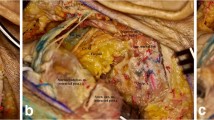Abstract
Background
The anterolateral (juxtacondylar) approach with limited mastoidectomy is a suitable option to expose the postero-inferior part of the jugular foramen (JF). It is particularly indicated for tumors extending in the neck beyond the jugular foramen, especially in those cases necessitating both neck control as well as control of the mastoid segment of facial nerve.
Method
We describe here the steps to safely perform an anterolateral approach with mastoidectomy along with a brief description of its indications and limits.
Conclusion
This approach represents a valid option to reach the JF. Its knowledge can improve the process of optimal approach selection when dealing with complex pathology involving the JF.






Similar content being viewed by others
References
Bond JD, Zhang M (2020) Compartmental subdivisions of the jugular foramen: a review of the current models. World Neurosurg 136:49–57
Bruneau M, George B (2008) The juxtacondylar approach to the jugular foramen. Neurosurgery 62(3 Suppl 1):75–78
Chibbaro S, Mirone G, Makiese O, George B (2009) Multilevel oblique corpectomy without fusion in managing cervical myelopathy: long-term outcome and stability evaluation in 268 patients. J Neurosurg Spine 10(5):458–465
George B, Lot G, Tran Ba Huy P (1995) The juxtacondylar approach to the jugular foramen (without petrous bone drilling). Surg Neurol 44(3):279–284
Hara T, Mahmoud MS, Martinez-Perez R, McGahan BG, Hardesty DA, Albonette-Felicio T, Carrau RL, Prevedello DM (2022) Morphometric comparison of Fisch type A and endoscopic endonasal far-medial supracondylar approaches to the jugular foramen. J Neurosurg 1–11
Komune N, Matsushima K, Matsushima T, Komune S, Rhoton AL (2016) Surgical approaches to jugular foramen schwannomas: an anatomic study. Head Neck 38(1):E1041-1053
Lesueur P, Calugaru V, Nauraye C et al. (2019) Proton therapy for treatment of intracranial benign tumors in adults: a systematic review. Cancer Treat Rev. https://doi.org/10.1016/j.ctrv.2018.11.004
Tykocki T, Poniatowski ŁA, Czyz M, Wynne-Jones G (2018) Oblique corpectomy in the cervical spine. Spinal Cord 56(5):426–435
Weber DC, Bizzocchi N, Bolsi A, Jenkinson MD (2020) Proton therapy for intracranial meningioma for the treatment of primary/recurrent disease including re-irradiation. Front Oncol 10:558845
Author information
Authors and Affiliations
Corresponding author
Ethics declarations
Consent to participate
The patient/next of kin/guardian has consented to the submission of this “How i Do it” to the journal.
Conflict of interest
The authors declare no competing interests.
Additional information
Publisher's note
Springer Nature remains neutral with regard to jurisdictional claims in published maps and institutional affiliations.
Key Points
The anterolateral approach is an option to expose the postero-inferior part of the jugular foramen (JF). It is particularly indicated for tumors extending beyond the JF requiring neck control and facial nerve decompression.
Neuromonitoring is mandatory to clearly confirm a proper identification of all the delicate neural structures exposed through this complex approach.
Extensive tumors may require combining this approach with other complementary alternatives such as the endoscopic endonasal approach to address the aspect of the JF.
Partial mastoidectomy and limited petrous bone drilling can be added to control the facial nerve and improve the visualization of the JF.
VA is identified in the suboccipital triangle and facilitated by palpation of the transverse process of C1. The periosteal sheath around the VA should be preserved to avoid major bleeding from the venous plexuses. Drilling of the condyle is usually unnecessary.
The medial wall of the IJV is kept intact and used as a “protection” during the resection of the tumor inside the JF.
This article is part of the Topical Collection on Tumor—Meningioma
Supplementary Information
Below is the link to the electronic supplementary material.
Supplementary file1 Video illustrating in details the surgical procedure (MP4 79127 KB)
Rights and permissions
Springer Nature or its licensor (e.g. a society or other partner) holds exclusive rights to this article under a publishing agreement with the author(s) or other rightsholder(s); author self-archiving of the accepted manuscript version of this article is solely governed by the terms of such publishing agreement and applicable law.
About this article
Cite this article
Giammattei, L., Passeri, T., di Russo, P. et al. Anterolateral (juxtacondylar) approach with limited mastoidectomy to resect a jugular foramen meningioma. Acta Neurochir 165, 1309–1314 (2023). https://doi.org/10.1007/s00701-022-05482-6
Received:
Accepted:
Published:
Issue Date:
DOI: https://doi.org/10.1007/s00701-022-05482-6




